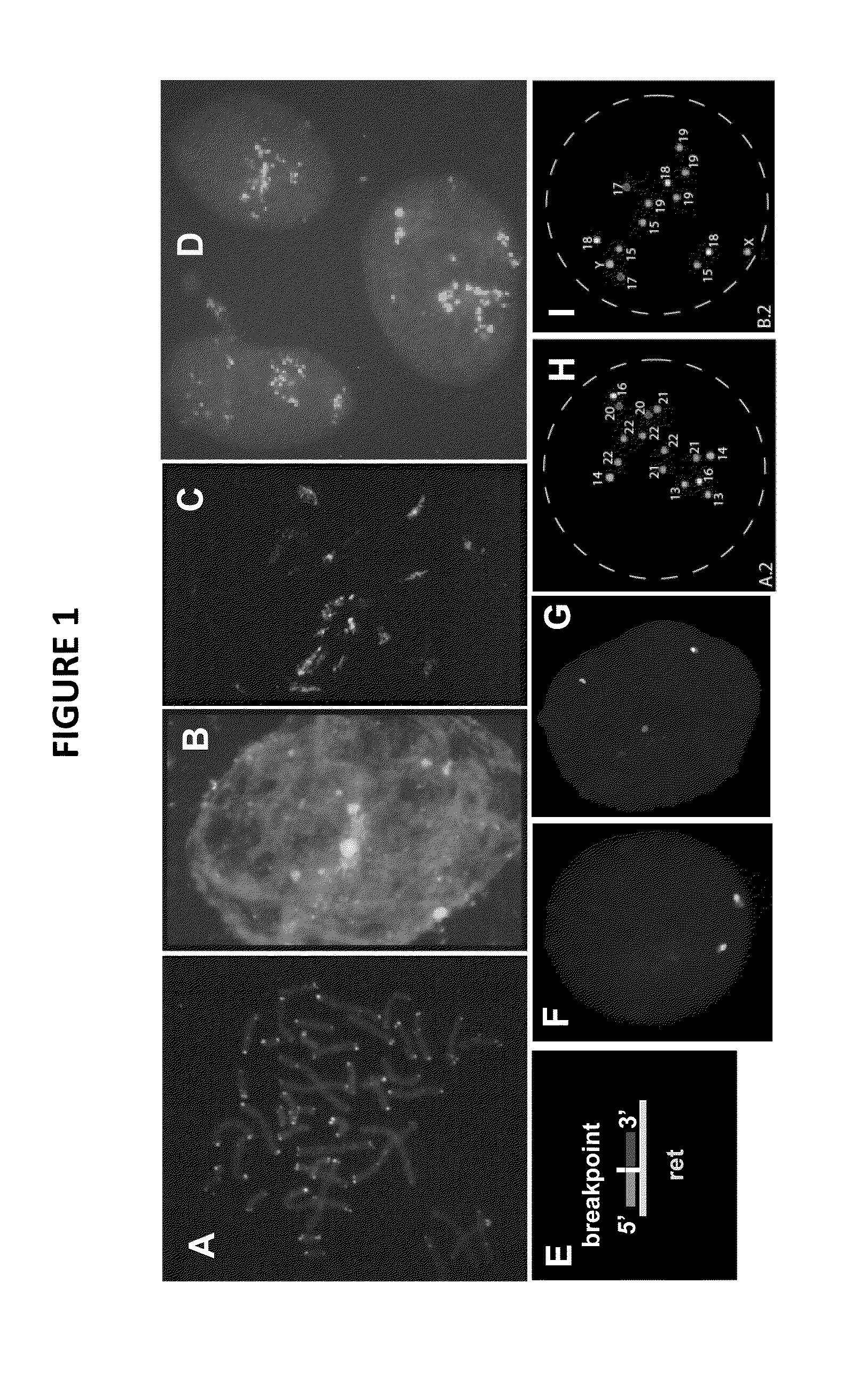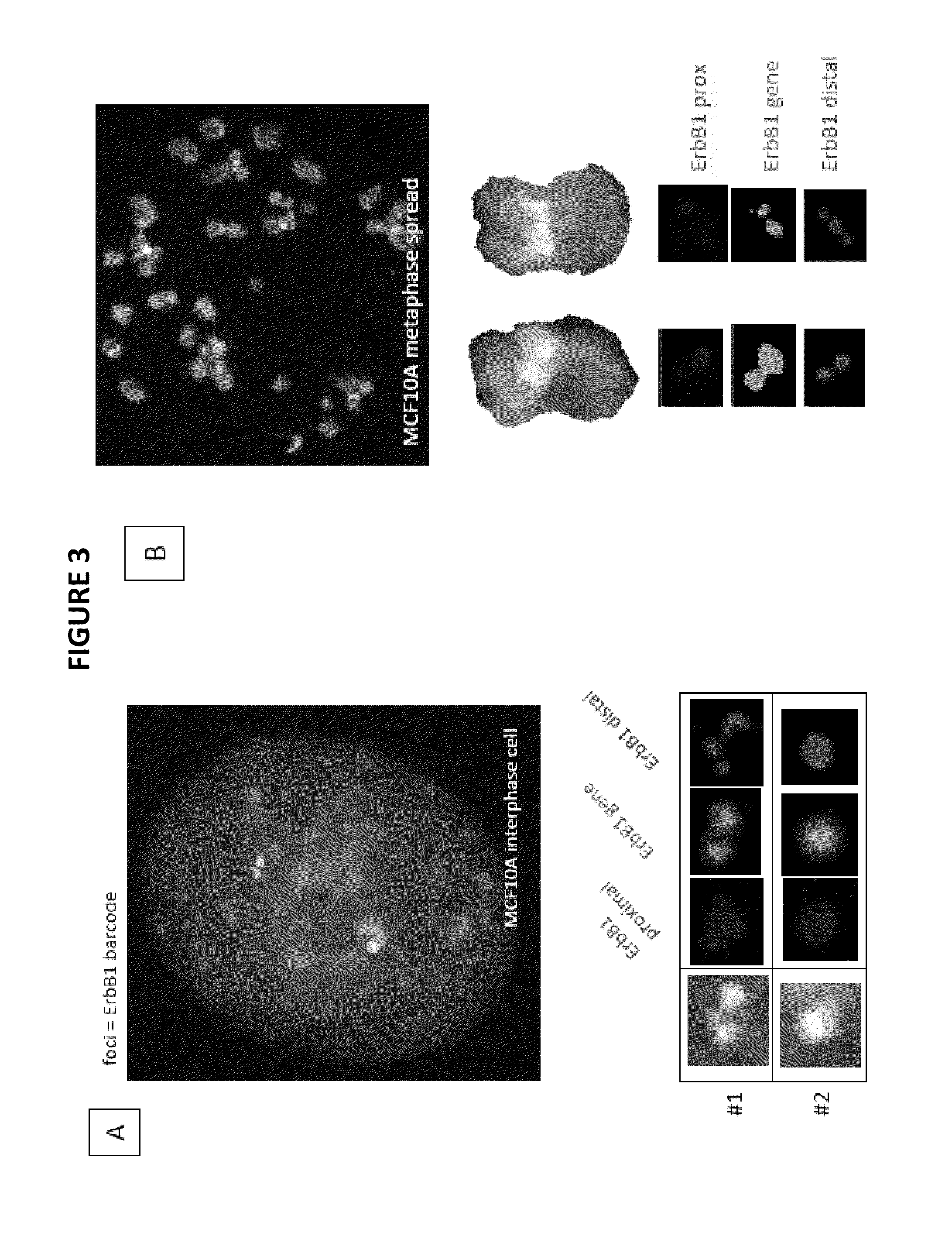Genetic Barcodes
a technology of fluorescence probes and barcodes, applied in the field of fluorescence probes and genetic barcodes, can solve the problems of no single experiment assay, no diagnostic assay that allows an accurate detection of rearrangements, etc., and achieves accurate and inexpensive fluorescence in situ hybridization, facilitate clinical application, and enhance the detection of chromosomal change
- Summary
- Abstract
- Description
- Claims
- Application Information
AI Technical Summary
Benefits of technology
Problems solved by technology
Method used
Image
Examples
example 1
Using Genetic Barcodes to Detect Er Status in a Panel of Cancer Cell Lines
[0069]Probes to ErbB1 gene and the proximal and distal regions were made from BAC probes from the RP11(CHORI) or CTD (Caltech) libraries. Methods to make such probes are described above and in International application WO 2006 / 091979, which is US Patent Publication No. US-2009-0098534-A1, hereby incorporated by reference.
[0070]Detection of specific abnormalities and DNA probes preparation was a carried out in cancer cell lines. In FIG. 3, a FISH barcode staining pattern in MCF10A non-malignant cells. MCF10A cells were shown to have 2 foci of the ErbB1 barcode with each foci containing each component contig, with each of the foci clearly on a separate chromosome and the predominant (86% of cells) pattern in the culture is 2 foci.
[0071]Referring now to FIG. 4 genetic amplifications / translocations were identified by a genetic barcode in cancer cells. MDA-231 cells have 5 foci identified by the ErbB1 barcode, with...
example 2
Using Genetic Barcodes to Detect ER Status in a Patient Biopsy
[0074]Present work focuses on the development of clinical assays for the detection and characterization of genetic alterations in tumor cells, and investigation of a potential correlation between tumor cell genotype and disease progression and outcome.
[0075]Detection of specific abnormalities and DNA probes preparation in cancer cell lines is described in Example 1 and FIG. 1. Clinical application of the assay is expected. In collaboration with scientists at the Hormone Receptor Laboratory, University of Louisville (U Louisville), KY, (Dr. James Wittliff, P.I.), we will select tissue specimens obtained from breast cancer patients for which extensive follow-up data is available, and investigate whether ErbB gene alterations besides estrogen and progesterone receptor status (‘ER and PR status’) are important prognostic parameters.
example 3
Using Genetic Barcodes to Detect Gene Status in Cell Lines
[0076]We also began investigating chromosomal rearrangements in breast cancer cell lines. We now have FISH probe sets (2-3 colour) for several additional cancer / disease associated genetic loci (in addition to the previous ones for the ErbB 1, ErbB2, AURKA and RET loci).
[0077]FIGS. 9A, 9B and 9C show examples of analyzing the A) HIPK2, B) PTEN, and C) XPG / ERCC5 gene loci. FIGS. 9A and 9B show the Homo Sapiens homeodomain interacting protein kinase 2 (HIPK2) gene locus in interphase cell nuclei, a protein kinase implicated in cancer chemoresistance, through either regulation of p53 mediated apoptosis or HIF1A mediated angiogenesis and cellular proliferation. This serine / threonine kinase involved in a preapoptotic pathway is a possible cancer therapy target, since it was found rearranged in 40-60% of various human cancers (Yu, J.; Deshmukh, H.; Gutmann, R. J.; Emnett, R. J.; Rodriguez, F. J.; Watson, M. A.; Nagarajan, R.; Gutman...
PUM
| Property | Measurement | Unit |
|---|---|---|
| Size | aaaaa | aaaaa |
Abstract
Description
Claims
Application Information
 Login to View More
Login to View More - R&D
- Intellectual Property
- Life Sciences
- Materials
- Tech Scout
- Unparalleled Data Quality
- Higher Quality Content
- 60% Fewer Hallucinations
Browse by: Latest US Patents, China's latest patents, Technical Efficacy Thesaurus, Application Domain, Technology Topic, Popular Technical Reports.
© 2025 PatSnap. All rights reserved.Legal|Privacy policy|Modern Slavery Act Transparency Statement|Sitemap|About US| Contact US: help@patsnap.com



